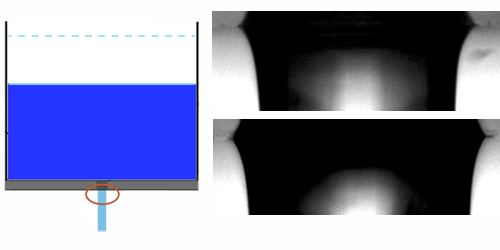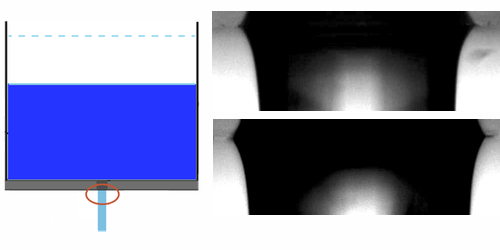Wetting Matters When Emptying a Tank
Make a hole in the bottom of a tank and the water it contains will flow out. How quickly the tank empties depends on the shape of the tank, the size of the hole, and, importantly, the initial amount of water (the rate at which the tank drains decreases as it empties). Now researchers from École Normale Supérieure de Lyon, France, have shown that how the water wets the tank’s external surface as it exits the hole also plays a role. This finding offers an explanation forwhy identically shaped tanks sometimes empty at different rates.
Eric Freyssingeas and colleagues filled a glass tank with water and unplugged a millimeter-sized hole in the bottom of the tank. They filmed the water jet exiting the tank and tracked the drainage rate. To alter the wetting properties of the tank, they switched the bottom glass plate with plates whose external coatings had different affinities for water.
The water drained fastest for glass or Teflon coatings, materials that have opposite interactions with water—water wets glass, but is repelled by Teflon. (Changing the inside coating of the tank had no effect.) However, the water drained slowest for coatings whose wettability was between that of water and Teflon. According to their calculations, the cause of this nonmonotonic behavior is the shape of the small ring of fluid that forms around the outside of the hole just as the water exits. In all cases, the presence of this ring causes the draining fluid to accelerate when compared to a completely straight jet, explaining why tanks sometimes empty more quickly than expected. The degree of acceleration depends on the specific ring shape—itself a wetting-dependent property, leading to the variations seen in the experiments.
This research is published in Physical Review Letters.
–Katherine Wright
Katherine Wright is a Contributing Editor for Physics.





